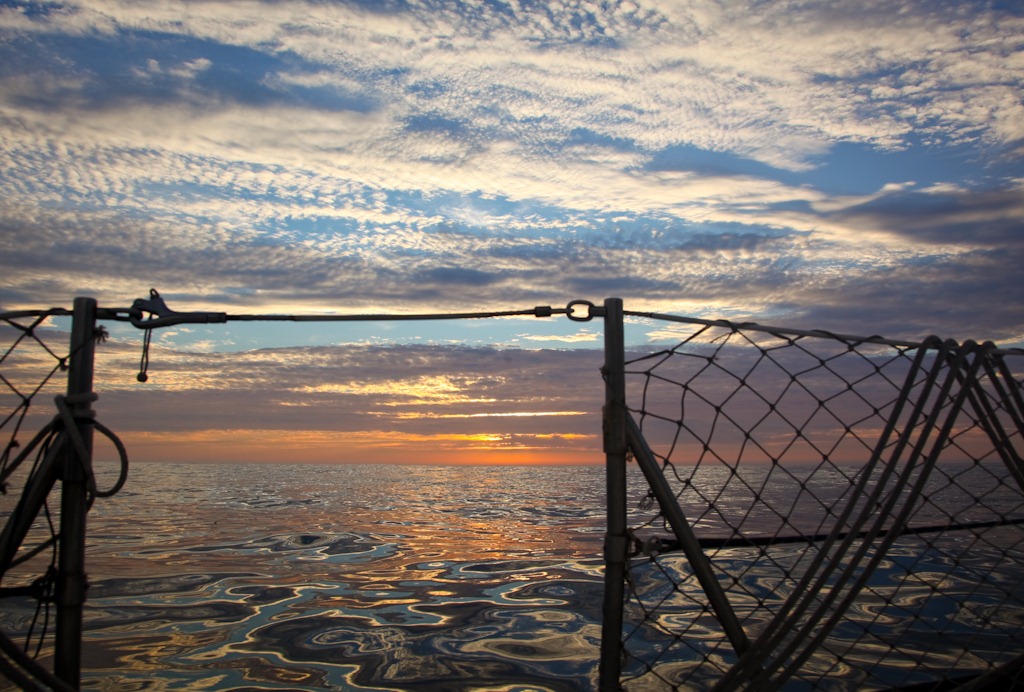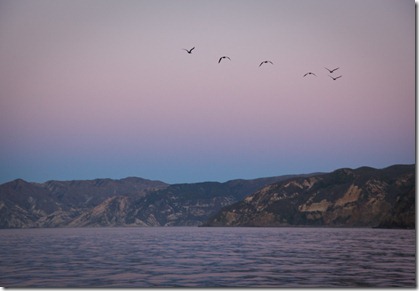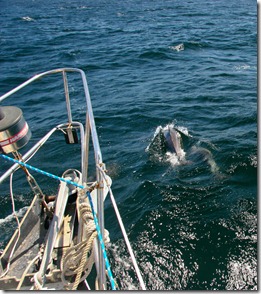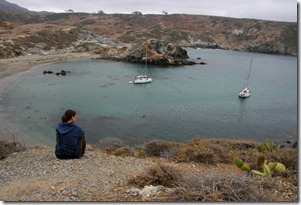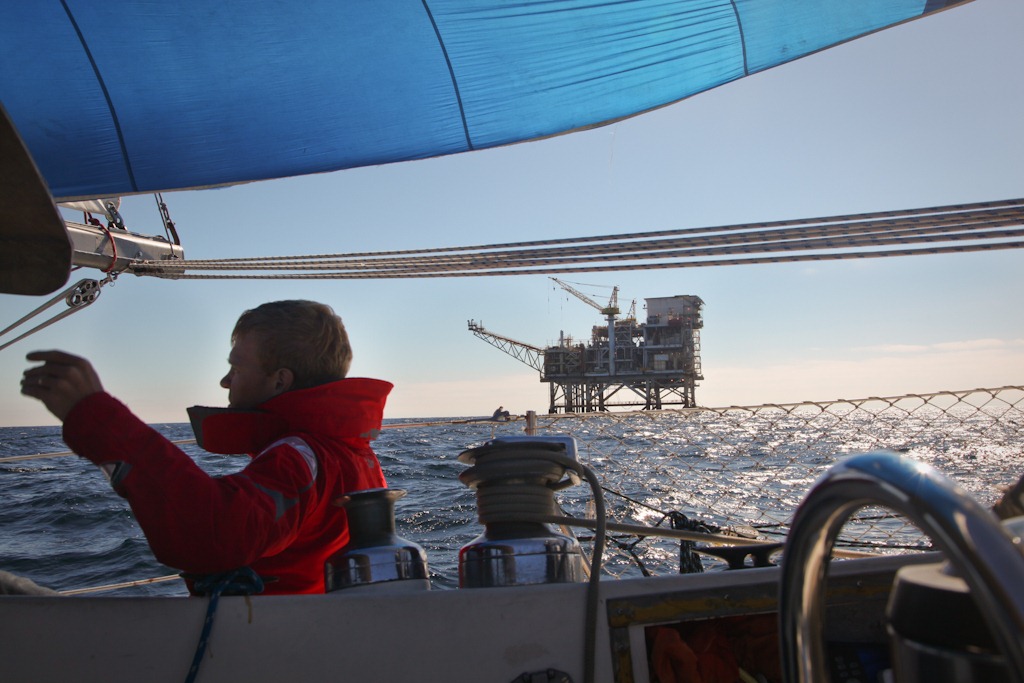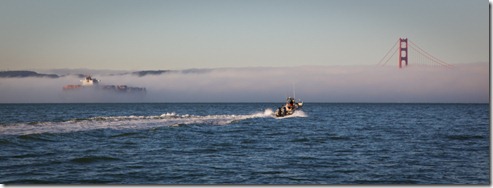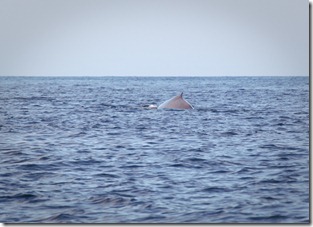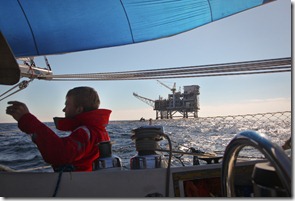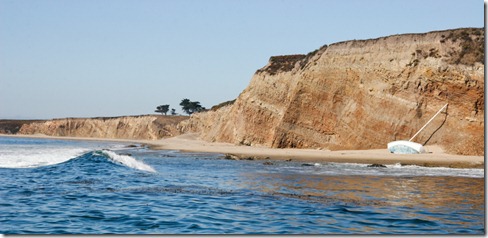September 24th – October 4th, 2010
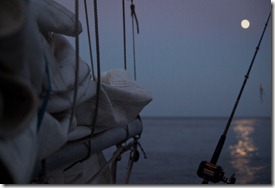 The passage to Santa Cruz began perfectly. We had strong wind, a beautiful sunset, and a full moon lighting our way as we went. Unfortunately it wasn’t long before the wind died and we were motoring again. Motoring isn’t terrible; the hum of the motor is close enough to white noise that it doesn’t inhibit sleep, and it’s easy enough to escape by going on deck. I hope that when Jen and I are making passages in the future we’re able to take our time so that we don’t have to run the motor so much, and instead just sail more slowly and take a few extra days to reach our destination. One thing I’ve learned on this trip, however, is that it is not only slower to sail under wind power alone, but when the wind is light enough and the sea is of any size at all, the motion of the boat tends to become very uncomfortable, and it becomes difficult to even steer the boat. So in many cases we may have no choice but to motor if the wind doesn’t cooperate.
The passage to Santa Cruz began perfectly. We had strong wind, a beautiful sunset, and a full moon lighting our way as we went. Unfortunately it wasn’t long before the wind died and we were motoring again. Motoring isn’t terrible; the hum of the motor is close enough to white noise that it doesn’t inhibit sleep, and it’s easy enough to escape by going on deck. I hope that when Jen and I are making passages in the future we’re able to take our time so that we don’t have to run the motor so much, and instead just sail more slowly and take a few extra days to reach our destination. One thing I’ve learned on this trip, however, is that it is not only slower to sail under wind power alone, but when the wind is light enough and the sea is of any size at all, the motion of the boat tends to become very uncomfortable, and it becomes difficult to even steer the boat. So in many cases we may have no choice but to motor if the wind doesn’t cooperate.
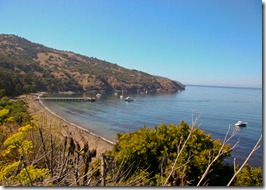 Upon making landfall at Santa Cruz island, we passed by several prospective anchorages, finding none of them to our liking, and finally settled on Prisoner’s Harbor. Prisoner’s harbor is the easternmost anchorage where you can go ashore without a permit. There is a pier and some structures used by the Park Service. We spear fished in the morning with much success including bagging one of the elusive Kelp Bass. The fishing on Santa Cruz island was generally quite good, despite the frigid and slightly murky water. I think the fish on Catalina have learned to be a bit more wary of divers. In the afternoon Jen and I pulled to shore and went for a hike. The only hiking trail we could find was a dirt road. There were good views of the coastline and some of the more rugged terrain the island had to offer, but it would have been nice to have found a more primitive trail. We tried some bushwhacking out to a point with a nice view, but the overgrown grasses were full of burrs that made it pretty unpleasant.
Upon making landfall at Santa Cruz island, we passed by several prospective anchorages, finding none of them to our liking, and finally settled on Prisoner’s Harbor. Prisoner’s harbor is the easternmost anchorage where you can go ashore without a permit. There is a pier and some structures used by the Park Service. We spear fished in the morning with much success including bagging one of the elusive Kelp Bass. The fishing on Santa Cruz island was generally quite good, despite the frigid and slightly murky water. I think the fish on Catalina have learned to be a bit more wary of divers. In the afternoon Jen and I pulled to shore and went for a hike. The only hiking trail we could find was a dirt road. There were good views of the coastline and some of the more rugged terrain the island had to offer, but it would have been nice to have found a more primitive trail. We tried some bushwhacking out to a point with a nice view, but the overgrown grasses were full of burrs that made it pretty unpleasant.
The next day we motored over to Painted Cave in the hope of being able to take the dinghy in, but the surge precluded it. We found good views all the same. We doubled back under sail to Fry’s Harbor. Fry’s was a gorgeous, small anchorage tucked far back in a bight in the coast. We had to set a stern anchor to limit how far we would swing because of our proximity to the rocky shore. As usual we did some more diving and fishing. In the evening we had a delicious meal of coconut curry and enjoyed our last night on the hook.
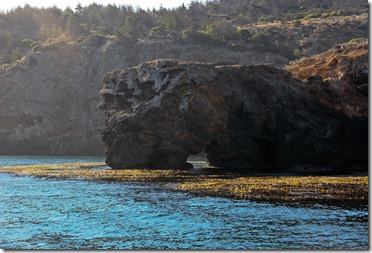
Monday the 27th we were headed back north. We sailed on passed Point Conception in calm conditions. The oil platforms created quite a spectacle as they lit up the sky burning off excess gasses. Unfortunately it wasn’t long before the wind abandoned us again and we were force to press on under power. We abandoned our plan to stop at Morro Bay because of the large swell running and reports of breakers in the harbor entrance. We pressed on to Monterrey.
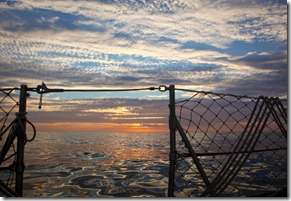 On our way north I spent a lot of time thinking about what lay ahead for Jen and I. We finally had our boat, but that meant we now had over 100 small to large projects to accomplish. We had more stuff to get rid of. We still had a lot to learn before we could go cruising on our own. I had work to complete, including a trip to Seattle. Combined with my worries over Jen’s feelings about our present trip and our future these things produced in me a state of anxious excitement. It was all a bit overwhelming, but there is no better place to meditate on ones future that in the solitude of the sea.
On our way north I spent a lot of time thinking about what lay ahead for Jen and I. We finally had our boat, but that meant we now had over 100 small to large projects to accomplish. We had more stuff to get rid of. We still had a lot to learn before we could go cruising on our own. I had work to complete, including a trip to Seattle. Combined with my worries over Jen’s feelings about our present trip and our future these things produced in me a state of anxious excitement. It was all a bit overwhelming, but there is no better place to meditate on ones future that in the solitude of the sea.
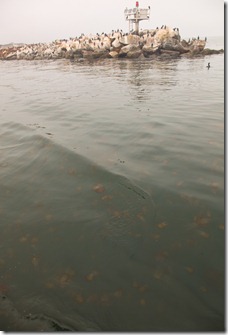 Our stay in Monterey was quite a relief. We were able to get a full night’s sleep, and a long, free, hot shower. It was nice to stand under the streams of steaming hot water for minutes, letting the week’s worth of salt and sweat wash down the drain seemingly taking the stress and worries with them. Feeling like new we went into town, stocked up on groceries, took care of some boat paperwork at Kinko’s, and went out for lunch.
Our stay in Monterey was quite a relief. We were able to get a full night’s sleep, and a long, free, hot shower. It was nice to stand under the streams of steaming hot water for minutes, letting the week’s worth of salt and sweat wash down the drain seemingly taking the stress and worries with them. Feeling like new we went into town, stocked up on groceries, took care of some boat paperwork at Kinko’s, and went out for lunch.
From Monterey we did a day sail over to Santa Cruz (the town, not the island). It was a great sailing day with a moderate NW wind allowing us to reach the whole way. We spend our time practicing manual navigation; using triangulation and running fixes of visual landmarks along with dead reckoning and depth changes to bring us within 100 yards of our target, a buoy off the Santa Cruz pier. We anchored there, within a few boat lengths of the pier and within sight of Steamer Lane, the famous Santa Cruz surf spot. I characteristically wasted no time donning my wetsuit and paddling the half mile over on the longboard. The wind had died for the evening and a moderate northwest swell was running. I got a couple of quality waves, although it was hard to spot and avoid the kelp. As dusk fell the land based crowd dwindled, opening the spot up for some of my best rides. By the time I made the long paddle back to the boat I could barely see the waves anymore, nor convince my arms to move much.
The next morning Jen and I made the slightly more sane paddle over to Cowell’s. We’re were one of the first people out, so despite the small size and infrequency of the sets we had a pretty good time. The last time we were out at Cowell’s the break had been so thick with newbies that every ride was a party wave, slaloming through packs of clueless beginners drifting inside, and almost ending with a gentle collision. I always try to be good natured and have a good time in such beginner breaks – after all we all had to start somewhere, but the empty break was a welcome change. When the morning surf classes hit the water and things started to get congested we headed back to the boat.
We got underway later that morning. As Bill got us going on his own the motor suddenly died after the anchor was up. He tried to deploy the Jib to sail us out of harms way, but with scant distance between us and the pier, he gave the order to drop the anchor and disappear below. We got the anchor down and the sail furled in short order. We could have hit the pier with a rock. Everybody’s heart was thumping. Luckily Bill resolved the issue quickly and got us moving again.
We sailed in light winds for the first day and a half. On the first day out Jen and Bill saw two large humpbacks breaching fully out of the water. I was napping at the time so I can only imagine what it must have been like to see their hulking bodies erupt from the surface only to fall back again with a splash. Later that afternoon while I was on deck I called out that I had spotted what looked like a shark. There was a grey dorsal fin moving slowly through the water ahead. As we approached, we realized it wasn’t a shark at all. Instead it was the strangest looking fish we had ever seen. It was large and triangular with pronounced dorsal and anal fins but no tail at all. It’s mouth was beaklike, similar to that of a parrot fish. It rolled about on the surface ahead of us, finally submerging and gliding away as we slid passed slowly in the light wind. As it turned out it was a Pacific Sunfish, a very odd, jellyfish eating fish ranging up to XXX lbs.
On the second day out the wind freshened and by the early morning hours of the third we were under reefed sail and taking watches in pairs because it was so rough. We would be entering San Francisco bay around sunrise. We raced in doing 7-8 knots, first close hauled and then downwind under the bridge. I must have been beat, because I slept through the whole thing, a feat Jen found rather impressive considering the conditions around the gate.
A few hours later we were back in Richmond, 23 days after we left. The trip had been a success in my mind. We had learned an incredible amount about large boat sailing, boat maintenance, anchoring, mooring, etc. Sailing for such an extended period with an OCSC instructor proved to be invaluable. I could only hope I hadn’t worn out my welcome peppering him with questions every chance I got. It certainly could have been better. It could have been warmer, we could have caught more fish, we could have sailed more, we could have been able to make a second stop at Avalon and a stop at Morro Bay; but overall I had a good time, and looked forward to making the trip again in my own boat. Jen, however, may have seen things differently, but that is a story for her to tell.
